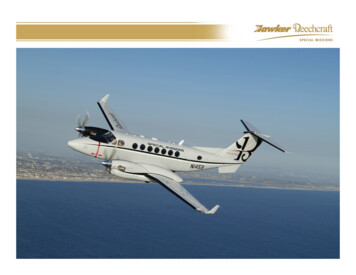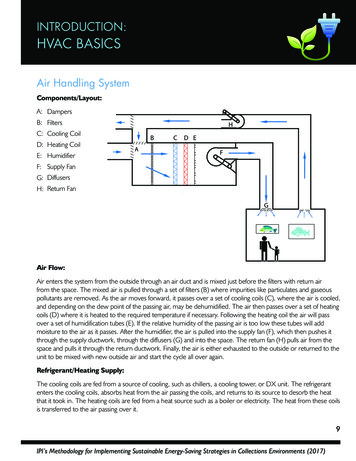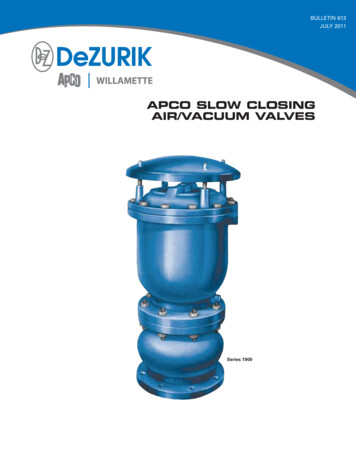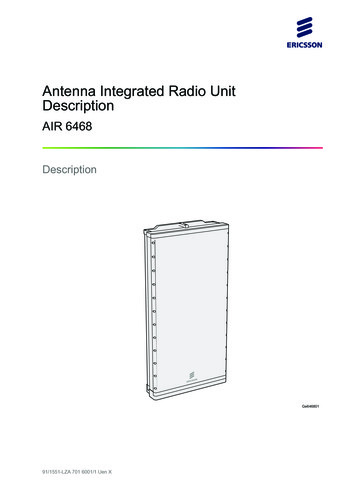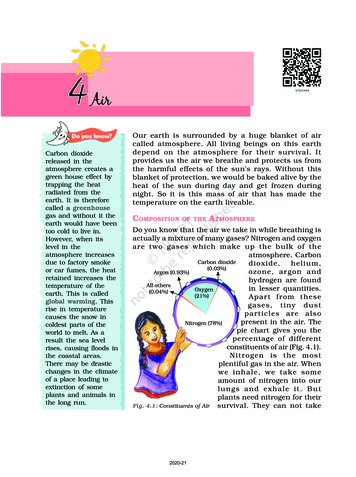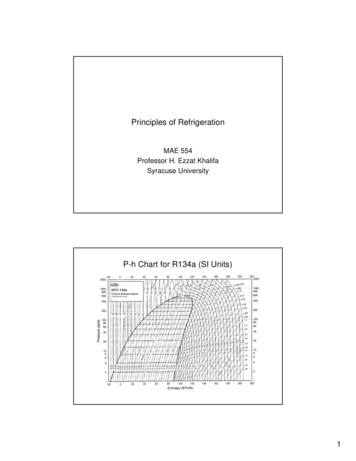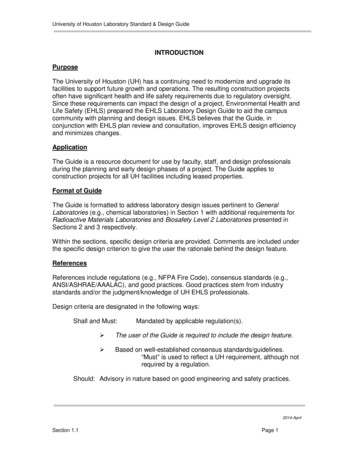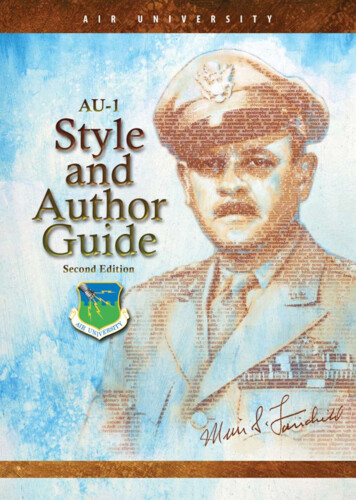
Transcription
Air UniversityStyle and Author GuideSecond EditionAir University PressAir Force Research Institute
Project EditorMarvin BassettISBN 978-1-58566-254-8Published by Air University Press in April 2015Cover Art, Book Design, and IllustrationsL. Susan FairComposition and Prepress ProductionMichele D. HarrellVivian D. O’NealPrint Preparation and DistributionDiane ClarkAIR FORCE RESEARCH INSTITUTEAIR UNIVERSITY PRESSDirector and PublisherAllen G. PeckEditor in ChiefOreste M. JohnsonManaging EditorDemorah HayesDesign and Production ManagerCheryl KingDisclaimerThe Air University Style and Author Guide provides guidance onwriting, editing, and publishing matters related to official publications of Air University. However, it is not directive and shouldnot be considered official Air Force or Department of Defensepolicy. This publication is cleared for public release and unlimited distribution.Air University Press155 N. Twining St., Bldg. 693Maxwell AFB, AL af.mil/http://afri.au.af.mil/AFRIAir Force Research Instituteii
ContentsFOREWORDvPREFACEviiNOTE ON CHANGES TO THE SECOND EDITIONixPart 1Air University Style Guide for Writers and Editors1.0Terms and Usage2.0Abbreviations293.0Grammar and Punctuation613.1 Grammar613.2 Punctuation71Mechanics854.1 Capitalization854.05.034.2 Spelling and Word Formation1034.3 Numbers1194.4 Italics1274.5 Display Dots133Documentation135AppendixANote Citations145BBibliographic Entries169CCopyright181BIBLIOGRAPHY183INDEX187iii
contentsPart 2Air University Press Author GuideAbout Us205Payment to Authors206Copyright206Classified and Sensitive Material206Security and Policy Review206Production Schedule207Accepted Manuscripts207Submission Instructions207Submitting a Manuscript to the Publication Review Board209Submitting an Accepted Manuscript for Publication209Formatting Your Manuscript209Formatting and Submitting Tables and Illustrations210Seed List for Index212Permissions213Distribution List214Checklist214AppendixAPublishing Agreement215BAuthor’s Checklist221CIllustrations Log225iv
ForewordAs the intellectual and leadership center of the Air Force, the Air University(AU) produces cutting-edge scholarship on airpower to advance our understanding of defense and national security issues. The Air University Style andAuthor Guide helps ensure that the form and style of AU scholarship are asimpressive as the substance.Like its predecessor, this second edition of AU-1, Air University Style andAuthor Guide, will prove to be indispensable to AU faculty, staff, students, andprospective authors. Faithful use of this guide will help the airpower communityproduce scholarly manuscripts that conform to current academic norms of style,format, language, and documentation.Part 1 of this publication, “Air University Style Guide for Writers and Editors,”provides guidance on such matters as grammar, mechanics, and documentationof sources. Part 2, “Air University Press Author Guide,” offers instructions forauthors who wish to submit manuscripts for possible publication by AU Press.In most matters, the Air University Style and Author Guide follows the ChicagoManual of Style, 16th edition, but it also addresses many military-specific mattersof style and mechanics that are not covered in most other style guides. AU-1 isan important reference tool for all AU writers, and I highly encourage its use.STEVEN L. KWASTLieutenant General, USAFCommander and President, Air Universityv
PrefaceWriting is easy. All you have to do is cross out the wrong words.—Mark TwainI am pleased to introduce the second edition of AU-1, Air University Styleand Author Guide. This edition reflects the latest guidance from the ChicagoManual of Style, 16th edition, and authoritative Department of Defensesources. It is designed to be useful to every researcher and writer at Air University, whether authoring a course paper, thesis, journal article, or book forpublication.The Style Guide includes part 1, “Air University Style Guide for Writers andEditors,” which has served as AU’s style manual since 2001, and part 2, “AirUniversity Press Author Guide,” which provides instructions for potential AUPress authors. The guidance in part 1 is divided into five sections: terms andusage, abbreviations, grammar and punctuation, mechanics, and documentation. Within each section, entries are arranged alphabetically.One strength of the Style Guide is its coverage of military style issues, suchas acronyms, military ranks, and specialized military terms. For this reason,the Style Guide may be of interest to those outside the Air Force who write oredit manuscripts about military issues. But it is also an accessible and authoritative source of guidance applicable to all disciplines: punctuation, thetreatment of numbers, grammar issues such as parallelism and passive voice,and so forth. New users will find the index helpful in locating specific topics.The Style Guide is also available electronically (a PDF file) from the AU Presswebsite, making it easily searchable for key terms.Of course, the Style Guide cannot address every aspect of writing or everystyle issue. For topics not covered here, users should consult the ChicagoManual of Style, 16th edition, which this guide follows in most matters. Webase spellings and definitions on Webster’s Third New International Dictionaryof the English Language, Unabridged, and Merriam-Webster’s Collegiate Dictionary, 11th edition (in the guide, the term dictionary refers to one or both ofthese sources). For advice on grammatical issues, we recommend the eighthedition of Index to English by Wilma R. and David R. Ebbitt or the seventhedition of Rules for Writers by Diana Hacker and Nancy Sommers.Many individuals at AU, the Air Force Research Institute, and AU Presshave contributed to the development of this second edition. It is an improve-vii
prefacement but undoubtedly imperfect. We invite interested writers and editors tosend comments and suggestions for later editions to Dr. Marvin Bassett, editorof the Air University Style and Author Guide (aupress.style@us.af.mil).ALLEN G. PECK, AD-26Director, Air Force Research Instituteviii
Note on Changes to the Second EditionNine years have passed since publication of the first edition of AU-1, AirUniversity Style and Author Guide, which replaced the Air University StyleGuide for Writers and Editors, also designated AU-1. The new AU-1 introduced expanded coverage of stylistic principles, a revised organizationalscheme, a numbering system to facilitate the location of entries, and an author guide to assist contributors in submitting their work to Air UniversityPress. Although the second edition of the guide retains those features, it offersboth new guidance and changes to existing principles occasioned by additionalexperience dealing with the needs of Air Force writers and by the appearanceof the 16th edition of the Chicago Manual of Style, AU-1’s authoritative sourceof stylistic guidance. It also adds tabs that allow users to locate the guide’s majorsections quickly and easily.Users of the guide will find much that is new in part 1, “Air University StyleGuide for Writers and Editors.” For example, section 1.0, “Terms and Usage,”revises the use of access dates in notes and bibliography entries (1.3); coversthe treatment of Arabic terms and names (1.10); updates the handling of classified sources (1.21); provides more in-depth advice about creating and alphabetizing an index (1.37); and offers more latitude in the use of subheadings (1.60). Section 2.0, “Abbreviations,” permits spelling-out of the titlesPresident and Senator and recommends use of the two-letter abbreviations ofthe US Postal Service. It also presents the digital object identifier (DOI) as amore stable locator than the URL (2.142); notes the new uppercase styling ofGlobal Positioning System (GPS) (2.194); adds the academic degree master ofphilosophy in military strategy (MPMS) from the School of Advanced Airand Space Studies (2.309); and clarifies the use of unmanned aircraft system(UAS) (2.477) and unmanned aerial vehicle (UAV) (2.478). Section 3.0,“Grammar and Punctuation,” addresses the handling of apostrophes in propernouns and possessives ending in silent “s” and an “eez” sound (3.2.1); it alsopermits the use of a comma following a question mark or an exclamationpoint in the title of a work (3.2.5). In section 4.0, “Mechanics,” users of theguide learn that (like Airman) Sailor, Soldier, and Marine are capitalized inreferences to US personnel (4.1.125, 4.1.135, 4.2.150); that the second element of a hyphenated number is capitalized in the titles of works (Lolita’sTwenty-First Birthday) and in the name of a numbered air force (TwentyThird Air Force) (4.1.149, 4.3.19); that they can choose between terms such asweb/website or Web/Web site (4.1.154); that they should follow the dictionary’s spelling of compound words with cyber and use open styling with cyberwords that don’t appear in the dictionary (4.2.62); that the term Koran hastwo secondary variants considered part of standard usage, as is the case withix
NOTE ON CHANGES TO THE SECOND EDITIONvariant forms of sharia (4.2.135, 4.2.222); that Shiite is the guide’s recommendedspelling (4.2.223); that an exception to the general rule for spelling wholenumbers occurs if several numbers appear in the same sentence, some normallyspelled out and some normally represented by numerals (4.3); that cardinalrather than ordinal numbers are used with abbreviations of military units(97th Air Mobility Wing / 97 AMW) (4.3.17); and that certain principles governwhether the names of websites or sections of websites are displayed in romantype, italics, or quotation marks (4.4). In section 5.0, “Documentation,” readersfind that the guide now clarifies the alphabetizing of single and multiauthorentries in a bibliography (5.1) and that the first paragraph of a block quotationis indented but not its subsequent paragraphs (5.2). Appendix A, “Note Citations,”now allows inclusion of the subject of a memorandum, offers guidance on documenting information found in blogs, and recommends forms of notes andbibliography entries for doctrine publications in light of the reorganization andrenaming of those publications by the Curtis E. LeMay Center for DoctrineDevelopment and Education. Finally, Part 2, “Air University Press AuthorGuide,” outlines the guidelines on copyright, fair use, and permissions thatAU Press has adopted from the University of Chicago Press. Thus, with thissecond edition, the Air University Style and Author Guide continues to fulfillits objective of meeting the needs of Air Force writers by providing the mostrecent and pertinent stylistic guidance available.x
Part 1Air University Style Guide for Writers and Editors
1.0Terms and UsageThis section contains explanations of the conventional use of selected common words (e.g., a or an, bimonthly, entitle or title, while)and of terms having distinctive meanings in publishing (e.g., caption,foreword, glossary, illustrations/figures, running heads, tables). It alsoprovides guidance on the use of terms that might prove distracting oroffensive to readers (e.g., Negro, profanity, sexist language) and identifies acceptable variants of certain words (e.g., US Air Force / Air Force/ USAF, weapon system / weapons system, World War I / World War 1/ First World War / Great War).1.1a/an. Use a before consonant sounds and an before vowel sounds: ahistorical event, not an historical event. Since an abbreviation is usually read as a series of letters or as a word, choose the indefinite articlein accordance with the pronunciation of the first letter (an NCA decision) or the pronunciation of the word (a NATO meeting).1.2above. You may use above to refer to information higher on the samepage or on a preceding page:The report found flaws in the above interpretation.1.3access date. An access date is the date on which you consult an onlineresource. You do not have to include it in a note or bibliography entry.You may wish to do so, however, if the resource has no date of publication or revision. If you do include an access date, place it beforethe URL or DOI, preceded and followed by a comma (in a note) or aperiod (in a bibliography entry). See also URL (2.486), DOI (2.142).1. “Glossary,” SitePoint, accessed 21 October 2010,http://www.sitepoint.com/glossary.php?q I.“Glossary.” SitePoint. Accessed 21 October 2010.http://www.sitepoint.com/glossary.php?q I.1.4aerospace. In general, use air and space (1.8) rather than aerospace.1.5aircraft. Show model designations by adding the letter without aspace: F-4C, B-52H.1.6air force. When referring to the air force of the United States, useUnited States Air Force, US Air Force, Air Force, or USAF. Use airforce to refer to an air force in general. See also 4.1 (capitalization ofarmies, navies, air forces, etc.).1.7Air Force–wide (adj., adv.). Use an en dash (3.2.6) in this compound.Terms and Usage1.0 TERMS AND USAGE 3
Terms and Usage4 1.0 TERMS AND USAGE1.8air and space. Use this term rather than aerospace.1.9and/or. Acceptable, but don’t overuse. According to Ebbitt and Ebbitt(see “Bibliography,” p. 185 of this guide), “and/or is used primarily inbusiness writing. . . . It is objected to by some readers because and/or looks odd and because and or or alone is often all that’s needed.But it’s sometimes useful when there are three alternatives—both theitems mentioned or either one of them: inflation and/or depression”(p. 24). See also slash (3.2.17).1.10Arabic terms and names. In transliterations of Arabic, use an apostrophe ( ’ ) to represent the hamza (Qur’an) and an opening singlequotation mark ( ‘ ) to represent the ‘ayn (‘Abd al-Rahman al-Jabarti).Use a hyphen to join the Arabic definite article, al, to a noun (alQaeda). For the titles of works and journals as well as the names oforganizations, capitalize only the first word and proper nouns; capitalize al only when it begins a sentence or the title of a work.Kitab al-Muqaffa al-kabirTahdhib al-kamal fi asma’ al-rijalAl-Qa’ida’s Doctrine for InsurgencyArabic surnames often include prefixes such as Abu, Abd, Ibn, al, orel, the capitalization of which varies. In general, lowercase such termsjoined with a hyphen; do not drop them when using the surname alone.Abdul Aziz Ibn Saud; Ibn SaudSyed Abu Zafar Nadvi; Abu Zafar NadviBarzan Ibrahim al-Tikriti; al-TikritiAlphabetize Arabic names by surname, using the part of the namefollowing the article al but retaining Abu, Abd, and Ibn.Abu Zafar Nadvi, SyedIbn Saud, Abdul AzizTikriti, Barzan Ibrahim al-1.11arms control (n.)1.12arms-control (adj.)1.13art, artwork. See illustrations/figures (1.36).1.14back matter. Elements following the main text of a book are knownas the back matter. In order, they include appendix(es), chronology(if not in the front matter), abbreviations (if not in the front matter),glossary, bibliography, list of contributors, and index(es). Use Arabicnumerals to number the pages of the back matter.
1.15below. You may use below to refer to information lower on the samepage or on a following page:These exercises, discussed below, are important to a unit’s training.1.16biannual, biennial. Biannual and semiannual mean twice a year;biennial means every two years; biannual can also mean every twoyears. For clarity, use twice a year or every two years.1.17bimonthly. Bimonthly can mean every two months or twice a month;semimonthly means twice a month. For clarity, use every two monthsor twice a month.1.18biweekly. Biweekly can mean every two weeks or twice a week. Forclarity, use every two weeks or twice a week.1.19black (people) (n., adj.). Use black (or Black) officer, black (or Black)people, blacks (or Blacks). See also white (people) (1.77).1.20caption. A caption, which describes an illustration or a figure, follows the number of the figure on a line parallel to and flush left withthe bottom of the figure. Place a period at the end of the caption if itis a complete sentence; preferably, use sentence-style capitalizationeven if it is not a complete sentence (see also titles of works [4.1.149];tables [1.62]). Do not use a period at the end of a caption that is anincomplete sentence unless you follow it with a complete sentence:Figure 1. Carrier air wing. As the Air Force assembles compositewings, it would do well to study how the Navy operates its carrier airwings. The composite nature of the carrier air wing is evident fromthis deck photo of the USS Theodore Roosevelt and its complementof aircraft.Figure 2. System flowchart applied to mission accomplishmentNote that the figure designation and caption may be set in boldface:Figure 2. Operationally responsive space: View of near-space architectureFigure 3. Responsiveness of space architecture. The ORS initiativedivides improvements in responsiveness into categories that includethe space vehicle, launch vehicle, and infrastructure. Improving eachof these areas simultaneously presents a challenge. (Reprinted frombriefing, Lt Col Gus Hernandez, Headquarters Air Force Space Command [AFSPC], Directorate of Plans and Requirements, subject: ORSOverview, 7 March 2005.)Use headline-style capitalization and italics for a work of art:Figure 9. Starry NightTerms and Usage1.0 TERMS AND USAGE 5
Terms and Usage6 1.0 TERMS AND USAGEYou may either spell out or abbreviate “figure,” and you may separate its number from the caption by using either a period or (if thefigure number and caption are typographically different) a space.Choose one style and use it consistently.Fig. 1. US bomb tonnage dropped on Germany by monthFigure 3 US airpower versus the worldPlate 3 Venice in winterIdentify the source of an illustration with a credit line, in parentheses, at the end of the caption. Use “reprinted from” or “adapted from,”depending upon whether you have copied the illustration or modified it, respectively:Figure 3. Competitive effects on general and administrative costs.(Adapted from Maj Paul G. Hough, “Financial Management for theNew World Order,” Airpower Journal 6, no. 3 [Fall 1992]: 51.)Figure 3. Responsiveness of space architecture. The ORS initiativedivides improvements in responsiveness into categories that includethe space vehicle, launch vehicle, and infrastructure. Improvingeach of these areas simultaneously presents a challenge. (Reprintedfrom briefing, Lt Col Gus Hernandez, Headquarters Air Force SpaceCommand [AFSPC], Directorate of Plans and Requirements, subject: ORS Overview, 7 March 2005.)For a photo obtained free of charge, place the photographer’s nameunderneath the photo and use the word “courtesy”:Photograph courtesy of Col Mike SchrieveMayor Lunsford at the groundbreaking ceremony for the industrialplant, September 2002. Courtesy of Cathi Fredericks.Unless fair use applies (see appendix C), copyrighted illustrationsrequire permission. (Generally, AU Press authors must obtain permission for all copyrighted illustrations to be reproduced in an AUPress publication.)Reproduced by permission from T. R. Fehrenbach, This Kind of War(Washington, DC [or D.C.]: Brassey’s, 2000), facing 237.If you use words such as left, right, top, bottom, or left to right toidentify individual subjects within an illustration, put them in italics,preceding the subjects they identify.Figure 1. Left to right: George Jones, Henry Johnson, and John HopkinsFigure 3. Upper left, B-1; upper right, F-15; lower left, C-5; center, XV-3;lower right, XV-15
If you include a list of illustrations, which follows the table of contentson a separate page, you do not have to reprint the captions exactly asthey appear in the text. If they are lengthy, you should shorten them.See also illustrations/figures (1.36).1.21classified sources. If your document will be available to the generalpublic, do not cite either classified information or the titles of classified documents (whether in the text, notes, bibliography, etc.).1.22click. One kilometer.1.23copyright. See appendix C of this guide.1.24dates. Write exact dates in the sequence day-month-year, withoutcommas. Use numerals for the day, spell out the month, and use afour-digit year. When you use only the month and year, no commasare necessary:FDR referred to 7 December 1941 as a day that would live in infamy.The date March 2003 was special to her.You may use 9/11 when referring to the terrorist attacks of 11 September 2001.1.25direct quotations. See quotations (5.7).1.26dot-com (n., adj.). A company that markets its products or servicesonline via a website.1.27East Berlin, East Germany. Use East Berlin or East Germany, notjust Berlin or Germany alone, in references to the city and countrywhen they were divided.1.28entitle, title (v.). The terms entitle and title are used interchangeablyin the sense of designating or calling by a title: A book entitled (ortitled) Roderick Random was on the list of required readings.1.29epigraph. An epigraph is a pertinent quotation that may be used atthe head of a chapter. Do not enclose an epigraph in quotation marks.Set it in italics in the same sized type as the text or in roman a sizesmaller. Do not place a note number at the end of an epigraph toidentify the source in a list of notes.A foolish consistency is the hobgoblin of little minds, adored by littlestatesmen and philosophers and divines.—Ralph Waldo EmersonEssays, First Series: Self-Reliance1.30figures. See numbers (4.3) or illustrations/figures (1.36), as appropriate.Terms and Usage1.0 TERMS AND USAGE 7
Terms and Usage8 1.0 TERMS AND USAGE1.31foreword. A foreword (not spelled forward) is part of the front matterof a book, appearing before the preface. Usually it is two to four pageslong and written by someone other than the author of the book. Thename of the person who wrote the foreword may appear at the end ofthe piece. See also front matter (1.32).1.32front matter. Elements preceding the main text of a book are knownas the front matter. In order, they include the title page, disclaimerpage (AU Press publications), dedication, epigraph, table of contents(which should list parts of the front matter that follow it but nonethat precede it), list of illustrations, list of tables, foreword, about theauthor page (AU Press publications), preface, acknowledgments (ifnot part of preface), introduction (if not part of text), abbreviations(if not part of back matter), and chronology (if not part of back matter). Use lowercase Roman numerals to number the pages of the frontmatter.1.33glossary. A glossary is an alphabetized list of terms and their definitions. See also back matter (1.14).Glossary of Internet TermsbrowsercookiedownloadA client program (software) that is used to look at variouskinds of Internet resourcesCommonly refers to a piece of information sent by a Webserver to a Web browser that the browser software is expectedto save and to send back to the server whenever the browsermakes additional requests from the serverTo transfer data (usually a file) from one computer to another—the opposite of uploadIf your text includes a number of acronyms or initialisms, you maywish to include them in a list of abbreviations (an umbrella term thatincludes both acronyms and initialisms), located before the bibliography.AbbreviationsAWACSLGBMANPADSAirborne Warning and Control Systemlaser-guided bombman-portable air defense system1.34headings. See subheadings (1.60).1.35idem (the same).1.36illustrations/figures. Illustrations or figures include graphics ofsome type, as seen in charts, graphs, “wiring diagrams,” and so forth.
They also include maps, photographs, and paintings. Tables (1.62) arenot considered illustrations.Number your illustrations consecutively throughout the text, andrefer to them by their numbers, either parenthetically “(fig. 8)” or aspart of the text:The totals shown in figure 3 are rounded off to the nearest dollar.Place an illustration as close to such a reference as possible, preferablyimmediately following the paragraph in which you first mention it.If each chapter in a book is written by a different author, the numbering of figures and tables restarts with each new chapter. For precise identification of figures and tables, use a combination of chapter number, a period, and figure/table number: 2.1, 2.2, 2.3, and soforth. If a book has appendixes with figures and/or tables, the numbers should include the letter of the particular appendix (A.1, A.2,B.1, B.2, C.1, C.2, etc.).If you include a gallery, a section consisting solely of illustrations,you don’t have to number the illustrations unless you refer to themin the text. If you have numbered illustrations in the text, other thanthose in the gallery, use, for example, “(fig. 1)” and “(plate 1)” to refer to an illustration in the text and to one in the gallery, respectively.Place a reference to the location of the gallery at the end of the tableof contents (e.g., “Illustrations follow page 150”).If you include a list of illustrations, place it on a separate page, following the table of contents. Title it “Illustrations” (without the quotation marks), but cite it in the table of contents as “List of Illustrations” (without the quotation marks):List of IllustrationsList of TablesForewordAbout the AuthorPrefaceContentsYou may either spell out or abbreviate “figure,” and you may separate its number from the caption by using either a period or (if thefigure number and caption are typographically different) a space.Choose one style and use it consistently.Fig. 1. US bomb tonnage dropped on Germany by monthFigure 3 US airpower versus the worldPlate 3 Venice in winterTerms and Usage1.0 TERMS AND USAGE 9
Terms and Usage10 1.0 TERMS AND USAGEIdentify the source of the illustration with a credit line. Place it atthe end of the caption, in parentheses, introduced by reprinted fromor adapted from, depending upon whether you have copied the illustration or modified it, respectively. Before using an illustration from acopyrighted source, obtain a formal (written) release from the copyright owner. See also caption (1.20); tables (1.62); appendix C.1.37index. An index helps the reader find details about particular subjects. Meaningful entries direct the reader to pertinent referencesin the text but not to passing remarks. Include terms relevant to thebook’s purpose—that is, key terms that a reader/researcher wouldfind useful. For example, you would expect to find terms such asSchwarzkopf, Norman; United States Central Command; and Operation Desert Storm in the index of a book on the Gulf War of 1991.However, you would not expect to find Orlando Country Club in thisindex even though the book may have mentioned in passing thatGeneral Schwarzkopf was a member. Just as you should not includeterms of peripheral interest, so should you omit obvious subjects. Forexample, there’s no point in including Arnold, Henry H. in the indexof a biography of Hap Arnold.You have some latitude in choosing which parts of a book to index.1. Do not index elements of the front matter such as the title page,dedication, lists of illustrations and tables, and acknowledgments.a. You may index the foreword and preface if they are aboutthe subject of the book rather than about how it came to bewritten.b. You may also index a true introduction, whether or not it ispart of the front matter.2. You should not index most of the back matter (glossary, bibliography, etc.).3. You may index appendices if they contain important information omitted from the main text of the book; do not index appendices if they merely reproduce a document (e.g., the text ofa treaty) discussed in the text.4. Do not index reference endnotes, but you may index textualendnotes (if you do, the index citation should include the pagenumber, n for note, and the note number [without spaces orpunctuation] [e.g., 134n14; 134nn14–16 (consecutive notes)]).5. You may index material in figures and tables if it is of particularimportance (e.g., 138 fig. 2; 311 table 6).
Create a concordance of key terms only after editing of the manuscript is complete. A concordance compiled before this stage mightinclude terms subsequently edited out and/or might omit terms added during editing. Similarly, any editing done after the index is generated could shift key terms to pages other than those indicated inthe index. If you add or delete key terms during proofreading andcorrecting page proofs, be sure to update the concordance to reflectthose changes. You can create a concordance as follows:1. Create a new document on your word processor.2. Open the file (preface, chapter, etc.) to be indexed.a. Select and copy a key term.b. Paste the term onto the newly created concordance file.(Copying and pasting are preferable to keying-in the termsince the latter introduces the possibility of error.)3. Repeat this process until you have listed all key terms (in a single column, with each term on a separate line) in the concordance file.4. Periodically, you may wish to alphabetize the terms in the concordance by using the word processor’s “sort” feature. By doingso, you can tell at a glance whether or not you have enteredduplicate terms (include the key term in the concordance onlyonce, regardless of how often it occurs in the manuscript).Note to authors submitting book manuscripts for publication byAU Press: You are responsible for submitting a seed list of key termsto be indexed, from which your editor will build a concordance. Seethe instructions for submitting manuscripts in part 2 of this styleguide. AU Press will generate the index, and your editor will edit itaccording to the procedures described below.Indexing software uses the concordance to generate an index thatincludes the page numbers on which the entries appear. You shouldthen edit the index, taking into account such features as the following:1. main entries (alphabetized [see discussion below]) and the pagenumber(s) on whic
Jun 12, 2017 · Manual of Style, 16th edition, and authoritative Department of Defense sources. It is designed to be useful to every researcher and writer at Air Uni-versity, whether authoring a course paper, thesis, journal article, or book for publication. The Style Guide includes part 1, “Air Univers




